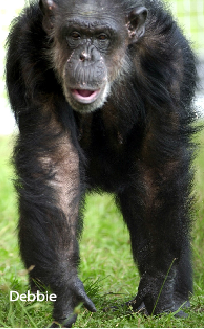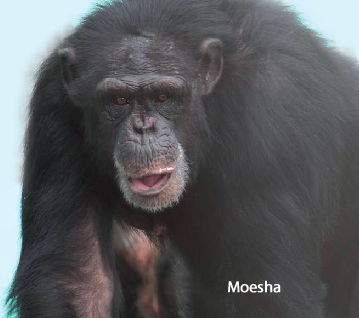Q: What is sanctuary life like for a chimpanzee rescued from a research lab?
A: Every chimpanzee is different, but by and large, lab chimps endured a barren existence, stuck in small cages of concrete and steel, with few creature comforts. To them, sanctuary is heaven. Every banana is an amazing treat, every platform to climb an unbelievable adventure. It’s quite wonderful to see how much the chimps enjoy and embrace their new lives. But it’s also very sad to think of how long these chimps went without such simple pleasures.
Q: How is the experience different for chimps who were once kept as pets?
A: That’s an equally sad story! Former pet chimps may certainly have endured barren conditions, since often owners banish adult chimps to cages. But these chimpanzees are very humanized and remember sleeping in a bed, eating ice cream, and watching TV. Former pet chimps in many ways don’t seem to realize that they are not human beings — and they are afraid of the noisy, hairy creatures (other chimpanzees) they are now seeing. It can be a difficult adjustment. The key to helping all of our chimpanzee residents feel happy and at home at Save the Chimps is to treat each of them as the individuals they are, and just take it one day at a time.
Q: Which chimpanzee has gone through the most radical change since arriving at Save the Chimps?
A: One chimp who has changed so much that I hardly recognize her is Moesha. When we rescued Moesha, she was a mess. She was thin, pale, and had a very thin coat of air. She was very high-strung — highly anxious, over-reactive, and extremely sensitive. She would scream, rock and clutch blankets to herself for comfort. I honestly wondered if she would ever make it in a social group. Well, I’m happy to say that Moesha proved me wrong. She is now a member of Tapioca’s Group, which is one of the loudest, most rambunctious groups at Save the Chimps. She is sassy, confident, and really enjoying her life.
Q: What are your happiest moments at the sanctuary?
A: Probably when chimpanzees are first released onto their island home and I get to watch those initial moments of freedom. Since I just talked about Moesha, I’ll share her amazing “first,” because it was quite a miracle. Many chimps born in research labs have never set foot on anything but concrete and steel. Grass is totally foreign to them. So it should come as no surprise that the first time they have a chance to go outside and onto the island, they are a little apprehensive. So imagine my surprise — and the tears in my eyes — when Moesha was the first chimpanzee in her group to bravely walk all the way out onto the island and climb up on a big wooden platform. She went out by herself, full of confidence, and pioneered the way for the other chimps in her family to follow her. It was amazing, and it remains one of my favorite moments.
Q: What surprises you the most about the sanctuary’s chimpanzee residents?
A: Their resiliency and ability to forgive. If I had to endure even a little of what most of these chimps had to endure, I’d be in a psychiatric institution, and I certainly would have little love for the human race. But they have such big hearts, they are able to heal and forgive. That’s not to say it’s OK to mistreat them because they can recover. It’s not OK. But we can certainly learn a big lesson from them about forgiveness —and about not judging a whole group of people based on the negative actions of a select few.
Q: What would you like to tell sanctuary supporters about what their generosity means to Save the Chimps?
A: I don’t think mere words can capture the depth of gratitude I have for our supporters. They mean everything to Save the Chimps. Nothing we do here would be possible without their compassion and generosity. To know that there are caring individuals out there who share my love of chimps, and are willing to help us keep this special sanctuary going … well, that keeps me going.


Learn about Chimp Life »


